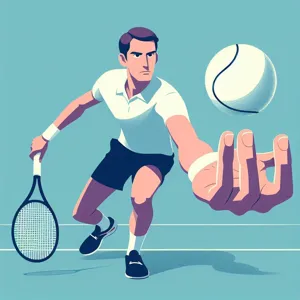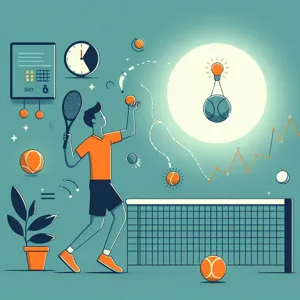In the fast-paced world of volleyball, the ability to receive serves effectively can make or break a game.
A well-executed serve reception not only sets the tone for your team’s play but also helps build confidence among players. As every seasoned athlete knows, mastering your return is an art that requires skill, strategy, and practice. Whether you’re a beginner aiming to enhance your fundamentals or a seasoned player looking to refine your techniques, understanding the nuances of serve reception is key to elevating your performance on the court. In this comprehensive guide, we will delve into the top strategies to improve your serve reception, from honing your footwork and positioning to mastering the mental aspects of the game. Get ready to transform your reception skills and become a more formidable force in every match!
1. Understanding the Importance of Serve Reception

Understanding the Importance of Serve Reception
In the fast-paced world of volleyball, serve reception is often the unsung hero of a successful game. It’s the first line of defense against an opponent’s attack, and its impact can be the difference between a win and a loss. When executed correctly, a solid serve reception not only neutralizes a powerful serve but also sets the tone for the entire play that follows.
A well-received serve gives your team the chance to establish a strong offense, enabling setters to deliver accurate sets to attackers. Conversely, a poor serve reception can lead to scrambling, miscommunication, and ultimately, lost points. This vital skill requires not just technical ability but also strategic thinking and a keen awareness of the game dynamics.
Understanding the nuances of serve reception begins with recognizing the various types of serves you might encounter—power serves, float serves, and jump serves, to name a few. Each type demands a different approach and technique, and mastering these can significantly elevate your game.
Moreover, serve reception is not solely an individual skill; it’s a team effort. Effective communication and positioning among teammates can enhance your collective ability to receive serves, allowing for smoother transitions from defense to offense. By honing your serve reception skills, you’re not only improving your personal performance but also contributing to a more cohesive and effective team dynamic.
In the following sections, we’ll delve into the top strategies for mastering serve reception, empowering you to improve your performance on the court and elevate your team’s success.
2. Analyzing Common Mistakes in Serve Reception
Analyzing common mistakes in serve reception is a crucial step toward mastering this fundamental aspect of volleyball. Every player, regardless of their skill level, can benefit from understanding the typical pitfalls that lead to missed serves or poorly executed receptions.
One of the most prevalent mistakes is improper body positioning. Players often stand too far from the net or neglect to align their body with the server, making it difficult to react effectively to the ball’s trajectory. A well-positioned player can anticipate the serve, allowing for a smoother and more controlled reception. Additionally, failing to maintain a low center of gravity can hinder agility—players should strive to keep their knees slightly bent, ready to move in any direction.
Another common error lies in the technique of the reception itself. Many players tend to use their hands instead of their forearms, resulting in an unstable platform for the ball. This not only increases the likelihood of mishandling the serve but can also lead to unnecessary injuries. Emphasizing the proper use of the forearms will create a more reliable and solid surface for receiving serves.
Players should also be aware of the psychological aspect of serve reception. Anxiety can lead to overthinking and hesitation, causing players to freeze when confronted with a powerful serve. Practicing mindfulness and focusing on breathing techniques can help players remain calm and collected, enhancing their ability to react instinctively rather than being paralyzed by fear.
Lastly, failing to communicate with teammates can result in chaotic situations on the court. Players should adopt a culture of vocalization, calling for the ball and signaling their intentions. This not only fosters teamwork but also ensures that everyone is on the same page, reducing the chances of mishaps.
By analyzing these common mistakes and making the necessary adjustments in technique, positioning, and communication, players can significantly improve their serve reception. In turn, this will enhance their overall performance on the court, paving the way for a more successful and enjoyable game.
3. Key Fundamentals of Serve Reception Technique

In mastering serve reception, understanding and implementing key fundamentals is crucial for elevating your game. The foundation of effective serve reception lies in three primary components: stance, platform, and movement.
**Stance**: Begin with a balanced, athletic stance, feet shoulder-width apart, and knees slightly bent. Ensure your weight is evenly distributed on the balls of your feet, ready for quick lateral movement. This position not only helps you react swiftly but also allows for better stability as you prepare to receive the serve.
**Platform**: Your platform is the foundation of your reception technique. Extend your arms forward, keeping your elbows straight and hands together, forming a solid, flat surface. This allows for optimal ball control. Position your hands in a way that they align with your forearms, creating a seamless surface that directs the ball where you want it to go. Remember, the angle of your platform can significantly influence the trajectory of the ball—tilting your arms slightly forward can help with aggressive serves, while angling them back can help with softer ones.
**Movement**: Finally, effective movement is essential for positioning yourself to receive the serve. As the server prepares to make contact with the ball, take a small step or two in the direction of the serve, keeping your eyes locked on the ball. Anticipate the trajectory and speed, adjusting your position accordingly. Being proactive rather than reactive allows you to receive the serve comfortably and with greater precision.
By mastering these key fundamentals—stance, platform, and movement—you’ll create a solid foundation for your serve reception technique. With practice, these elements will become second nature, allowing you to enhance your overall performance on the court and become a formidable opponent. Remember, consistent repetition and attention to detail are essential in honing these skills, so dedicate time to practice and watch your serve reception improve dramatically.
4. The Role of Footwork in Effective Serve Reception
Footwork is often the unsung hero of effective serve reception, yet it plays a pivotal role in determining how well you respond to your opponent’s serve. The foundation of any great reception starts with your positioning, and this is where footwork comes into play. Good footwork allows you to move swiftly and smoothly, enabling you to get into the optimal position to receive the ball.
When the server prepares to unleash their serve, your first instinct should be to anticipate the type of serve they will deliver. This anticipation requires not only a keen eye but also agile feet. As the ball is struck, your ability to sidestep or shuffle laterally can mean the difference between a smooth reception and a chaotic scramble. Aim to adopt a low, athletic stance with your feet shoulder-width apart, ready to spring into action.
Practicing various footwork drills can enhance your reaction time and agility. For instance, setting up cones on the court can allow you to train your lateral movement, helping you improve your speed and precision in adjusting your position. Quick stepping drills and shadowing exercises can also simulate real-game scenarios, allowing you to perfect the necessary footwork for different types of serves.
Moreover, remember that footwork isn’t just about moving toward the ball; it’s also about balance and control. As you prepare to receive, your feet should help you maintain a stable base, especially when the serve comes at high speed or with heavy spin. A well-balanced stance allows you to absorb the impact of the ball and respond effectively, whether you’re setting up for a pass or preparing to dig a tough serve.
Incorporating footwork drills into your practice routine is essential. By honing this skill, you’ll not only enhance your serve reception but also elevate your overall performance on the court. Remember, effective serve reception starts from the ground up; master your footwork, and you’ll be well on your way to becoming a formidable force in serve reception.
5. Developing Quick Reaction Skills for Better Reception

In the fast-paced world of volleyball, the ability to react swiftly can be the difference between a stellar serve reception and a missed opportunity. Developing quick reaction skills is essential for players who want to elevate their game and ensure they are consistently in the right place at the right time.
To hone these skills, start by incorporating reaction drills into your training regimen. One effective drill is the “reaction ball” exercise. This unique, bouncy ball is designed to unpredictably change direction upon impact, forcing players to stay alert and agile. By consistently practicing with this tool, you’ll train your body to respond instinctively to unforeseen movements, sharpening your reflexes.
Another beneficial approach is to engage in partner drills that simulate real-game scenarios. Have a teammate serve at varying speeds and angles while you focus on maintaining your stance and keeping your eyes on the ball. The more you expose yourself to different serve types, the better equipped you’ll be to react quickly during matches.
Additionally, consider implementing plyometric exercises into your workout routine. These explosive movements, like box jumps and lateral bounds, not only build strength but also enhance your overall reaction time by training your muscles to respond rapidly.
Incorporating visualization techniques can also play a significant role in improving your serve reception. Spend a few minutes before practice or matches visualizing different serve scenarios and imagining your successful reactions. This mental rehearsal can help reinforce your physical response, making it more instinctual when it matters most.
By focusing on these quick reaction skills, you’ll not only improve your serve reception but also boost your overall confidence on the court. Remember, the key is to practice consistently, stay focused, and always be ready to react. With dedication and effort, you’ll transform your serve reception into a formidable asset in your volleyball arsenal.
6. Strategies for Reading the Server’s Body Language
Understanding a server’s body language can be a game-changer when it comes to improving your serve reception. Body language often reveals a wealth of information that can help you anticipate the type of serve being delivered, allowing you to position yourself more effectively and respond with confidence. Here are some key strategies to help you read the server’s cues effectively.
First, pay attention to the server’s stance. A wide stance often indicates a powerful serve, whereas a more relaxed position might suggest a softer or strategic placement. Look for subtle shifts in weight; if the server leans back slightly before the toss, they may be preparing for a topspin serve, while a forward lean could signal a potential slice.
Next, observe the toss. The height and trajectory of the ball can provide invaluable clues about the serve’s intended direction and spin. A higher toss generally precedes a powerful serve, while a lower toss might indicate a more controlled shot. If the toss appears erratic or inconsistent, be ready to react quickly, as the server may be attempting to disguise their intentions.
Another critical aspect to watch is the server’s arm movement. The momentum and speed of their arm can signal whether they are going for a flat serve or something with more spin. A slow, deliberate arm motion often precedes a change-up serve, designed to catch you off guard. Conversely, a rapid arm swing usually indicates a fast-paced attack.
Lastly, don’t underestimate the power of eye contact. In some cases, servers will intentionally look in one direction before delivering the ball to mislead you. By maintaining focus and being aware of their gaze, you can decipher whether they’re likely to hit cross-court or down the line.
By honing your skills in reading a server’s body language, you’ll not only improve your serve reception but also gain a tactical edge in matches. The next time you step onto the court, remember that every subtle movement tells a story—be sure to listen closely!
7. Utilizing Different Stances for Varying Serve Types

When it comes to mastering your serve reception, one of the most effective strategies is to utilize different stances for varying serve types. The stance you adopt can significantly influence your ability to read, react, and respond to serves, allowing you to enhance your overall performance on the court.
For instance, a neutral stance is ideal for receiving a flat serve. By positioning your feet shoulder-width apart and slightly bending your knees, you create a stable base that allows for quick lateral movement. This posture enables you to react swiftly, keeping your weight balanced and ready to shift in any direction. In contrast, when anticipating a topspin serve, consider adopting a more forward-leaning stance. This slight shift in weight prepares you for the ball’s higher trajectory and allows for a more aggressive approach to the reception, facilitating an optimal transition into your next movement.
Additionally, mastering the side stance can be particularly beneficial for dealing with spin serves. By positioning your body sideways to the net, you gain a better angle for tracking the ball’s rotation. This stance not only enhances your visual perspective but also allows for quicker adjustments, giving you the agility to respond effectively to unpredictable spins.
As you practice these various stances, it’s crucial to integrate drills that simulate different serve types. This will not only help you get comfortable with each stance but also develop muscle memory, allowing you to react instinctively during matches. Remember, the key lies in adaptability—by fine-tuning your stances to match the type of serve you’re facing, you’ll significantly improve your serve reception and, ultimately, your game performance.
8. Practicing with Purpose: Drills to Enhance Serve Reception
When it comes to mastering your serve reception, intentional practice is paramount. Practicing with purpose not only sharpens your skills but also builds the muscle memory needed to react instinctively during a match. Here are some effective drills designed to elevate your serve reception game:
**1. Targeted Toss Drill:** Begin by focusing on your footwork and positioning. Have a partner or coach toss the ball to you from various angles, simulating different types of serves. As the ball approaches, concentrate on your stance and movement, ensuring you’re in the right position to receive the serve. This drill hones your ability to read the server’s body language and anticipate where the ball will land.
**2. Reaction Time Drill:** Enlist a partner to serve the ball at you from the baseline. As they serve, have them vary the speed and placement of their serves randomly. Your goal is to react quickly and adjust your body position accordingly. This drill is fantastic for improving your reflexes and adapting to different serve types, whether they’re flat, spin, or slice.
**3. Serve Reception Under Pressure:** Simulate match conditions by setting up a competitive environment. Play a series of short games where your opponent serves, and you must receive the serve while aiming to execute a successful return. Set a score, and push each other to perform under pressure. This not only builds your confidence but also allows you to practice your mental resilience during high-stakes scenarios.
**4. Video Analysis:** Record your serve reception during practice sessions. Analyzing your technique can reveal areas for improvement that you might not notice in real-time. Look for patterns in your footwork, hand positioning, and reaction time. This self-reflection can be invaluable for making necessary adjustments and tracking your progress over time.
**5. Visualization Techniques:** Away from the court, visualize yourself successfully receiving serves. Picture different scenarios—facing hard serves, tricky spins, or challenging placements. This mental rehearsal can enhance your focus and prepare your mind for actual matches.
By incorporating these purposeful drills into your training routine, you’ll not only improve your serve reception but also gain a deeper understanding of the dynamics involved in effectively handling serves. Remember, consistency is key; the more you practice with intention, the more confident and skilled you’ll become when it matters most on the court.
9. Building Mental Toughness and Focus During Matches
In the fast-paced world of volleyball, mental toughness and focus can often be the defining factors that distinguish a good player from a great one. When the pressure escalates, and the crowd’s roar reaches a crescendo, your ability to maintain composure becomes paramount. Building mental resilience is not merely about withstanding pressure; it’s about thriving in it.
To cultivate mental toughness, start with visualization techniques. Before each match, take a few moments to picture yourself executing perfect serve receptions. Visualize the feeling of the ball connecting with your forearms, the sound of the ball popping off your platform, and the subsequent rush of energy as you set up your teammates for success. This mental rehearsal can enhance your confidence and prime your mind for the real thing.
Breath control is another crucial element. In the heat of the moment, it’s easy to let anxiety creep in. Practicing deep breathing exercises can help ground you, allowing you to refocus and regain composure. When you feel your heart racing, take a moment to breathe in deeply through your nose, hold for a few seconds, and exhale slowly through your mouth. This simple technique can clear your mind and sharpen your focus, enabling you to react instinctively to the serve coming your way.
Moreover, developing a pre-match routine can establish a sense of familiarity and calm. Whether it’s listening to music, stretching, or engaging in light conversations with teammates, having a consistent ritual can help center your thoughts and prepare you for the game ahead.
Lastly, it’s essential to embrace a growth mindset. Understand that mistakes are part of the journey; each serve reception is an opportunity to learn and improve. When you view setbacks as stepping stones rather than failures, you equip yourself with the mental fortitude needed to bounce back stronger. By fostering these strategies, you can enhance your serve reception skills while building a resilient mindset that thrives under pressure, ensuring that you remain a key player in the match, no matter the circumstances.
10. Leveraging Team Communication for Improved Reception
Effective communication among team members is a cornerstone of successful serve reception. In the fast-paced environment of volleyball, where split-second decisions can determine the outcome of a point, clear and concise communication is vital. This means that every player, from the libero to the outside hitter, must be on the same page when it comes to anticipating and reacting to serves.
To leverage team communication effectively, start by establishing a set of verbal cues and signals that players can use during matches and practices. These can range from simple calls like “Mine!” or “Yours!” to more complex tactical announcements that indicate who will take the first touch or where to position themselves based on the server’s tendencies. By ensuring everyone understands and consistently uses these cues, you can reduce confusion and enhance your team’s overall cohesion.
Additionally, regular team meetings and video analysis sessions can provide a platform for players to discuss their observations and strategies regarding serve reception. By reviewing game footage together, players can identify patterns in opponents’ serving styles and work collaboratively to devise plans that capitalize on these insights. This shared understanding not only boosts confidence but also fosters a sense of accountability among teammates.
Moreover, practicing under game-like conditions can further solidify communication skills. Implement drills that simulate high-pressure scenarios, where players must rely on each other’s calls and positioning. The more they practice these situations, the more instinctual their communication will become during actual matches.
Ultimately, by prioritizing and refining team communication, you can transform your serve reception from a series of individual efforts into a synchronized unit, poised to handle any serve that comes your way. With improved reception, your team will not only enhance its defensive capabilities but also set up more effective attacks, leading to greater success on the court.
11. Analyzing Video Footage for Self-Improvement
Analyzing video footage is one of the most effective strategies for mastering your serve reception. In the age of technology, we have an incredible tool at our disposal: the ability to record and review our performances in high definition. This process not only helps identify areas of weakness but also reinforces effective techniques and strategies.
Start by capturing footage of your practice sessions or matches. Make sure to film from various angles to gain a comprehensive view of your positioning, footwork, and overall technique. When reviewing the footage, pay close attention to your stance and body positioning as the serve approaches. Are you balanced? Are your feet in the right place? These foundational elements can make a significant difference in your reception.
Next, analyze your reaction time and decision-making process. Do you seem hesitant or overly reactive? Look for patterns in your movements—do you consistently favor one side? By pinpointing these habits, you can adjust your training to focus on improving your weaknesses while solidifying your strengths.
Don’t forget the importance of comparing your footage against those of experienced players. Observing their techniques and strategies can provide valuable insights into how to enhance your own performance. Consider taking notes on their footwork, hand positioning, and timing, and try to incorporate these elements into your practice.
Finally, make it a routine to revisit old footage as you progress. This will not only help you track your improvement over time but also remind you of the specific areas you initially set out to enhance. Embrace the power of video analysis as a critical component of your training regimen, and watch your serve reception skills soar to new heights.
12. The Impact of Physical Conditioning on Serve Reception
Physical conditioning plays a crucial role in mastering your serve reception, often making the difference between a successful play and a missed opportunity. Athletes who prioritize their fitness not only enhance their overall performance but also significantly improve their ability to react to powerful serves. When your body is conditioned to withstand the rigors of a match, you’re better equipped to respond quickly and effectively to every serve that comes your way.
A well-rounded conditioning program focuses on several key areas: strength, agility, speed, and endurance. For instance, core strength is vital for maintaining balance and stability when positioning yourself for a reception. Exercises such as planks, medicine ball twists, and leg raises can bolster this aspect of your fitness, allowing you to stay grounded and controlled when the ball approaches at high speeds.
Agility drills are equally important, as you need to move swiftly and change direction on a dime. Incorporating ladder drills, cone sprints, or shuttle runs into your training routine will sharpen your responsiveness, enabling you to adjust your position seamlessly to meet the server’s trajectory. Meanwhile, plyometric exercises like box jumps and jump squats can enhance your explosive power, helping you to spring into action as the serve is delivered.
Endurance is another critical factor—matches can be long, and fatigue can lead to lapses in concentration and reaction time. Cardiovascular conditioning through running, cycling, or interval training ensures that you maintain peak performance throughout the game, allowing you to stay focused and ready to receive serves right up until the final point.
In addition to these physical components, don’t underestimate the mental aspect of conditioning. Visualization techniques can enhance your mental preparedness, allowing you to anticipate serves and execute your reception strategy with confidence. By cultivating both your physical and mental conditioning, you set yourself up for success in serve reception, ensuring that you are always one step ahead of your opponents.
13. Adapting to Different Opponents’ Serving Styles
Adapting to different opponents’ serving styles is crucial for mastering your serve reception and elevating your game to the next level. Each player brings a unique serving technique that can dramatically influence the dynamics of a match. Understanding and adapting to these varied styles not only enhances your defensive capabilities but also gives you a strategic edge in anticipating the ball’s trajectory.
Start by closely observing your opponent’s serving patterns during warm-ups or the early stages of the match. Take note of their grip, toss height, and body positioning, as these cues often reveal valuable information about the type of serve they prefer—whether it’s a powerful flat serve, a tricky slice, or a heavy topspin. Each serve demands a different response; for instance, a flat serve might require you to set your stance wider and lower, while a slice serve might necessitate a quicker lateral movement to adjust your position.
As you adapt, focus on your footwork and positioning. A well-timed split step can give you that extra edge, allowing you to react more swiftly to different serves. Practice drills that simulate various serving scenarios with a partner, emphasizing quick reactions and varied receptions. By drilling these scenarios, you’ll develop muscle memory that enables you to respond instinctively, regardless of your opponent’s serving style.
Additionally, don’t underestimate the mental aspect of adapting to serving styles. Stay patient and composed, particularly when facing a server whose style is unfamiliar or particularly challenging. Visualize successful receptions against different serves, reinforcing your confidence. Remember, the more you expose yourself to diverse serving styles—whether in practice or competitive play—the more adept you’ll become at adjusting your reception strategy. This adaptability not only improves your serve reception but also demonstrates to your opponents that you are a formidable player capable of handling any challenge that comes your way.
14. Setting Goals for Continuous Improvement in Serve Reception
Setting goals for continuous improvement in serve reception is a fundamental strategy that can elevate your game to new heights. Just like any skill in volleyball, refining your serve reception requires dedication and a clear vision of what you want to achieve. Start by assessing your current performance: how well do you handle different types of serves? Are there specific areas, such as technique or positioning, where you struggle? By identifying these weaknesses, you can set SMART goals—Specific, Measurable, Achievable, Relevant, and Time-bound—that will guide your training.
For instance, if you find that you struggle with high serves, set a goal to improve your reception accuracy on those specific plays within a month. Break this down into actionable steps, such as dedicating part of your practice sessions to receiving high serves, seeking feedback from coaches or teammates, and tracking your progress through drills or video analysis. Regularly revisit these goals to ensure you’re on track, adjusting them as necessary to continue challenging yourself and fostering growth.
Furthermore, consider incorporating mental goals alongside physical ones. Visualization techniques can enhance your confidence and focus, which are crucial during high-pressure moments in a match. By setting both physical and mental goals, you create a comprehensive improvement plan that not only boosts your serve reception skills but also fortifies your overall performance on the court. Remember, mastery is a journey, and through consistent effort and goal-setting, you can transform your serve reception into one of your greatest assets.
15. Conclusion: The Path to Mastering Your Serve Reception
In the world of volleyball, mastering your serve reception is not just about honing a skill; it’s about transforming your game and elevating your entire team’s performance. As we conclude this journey through the intricacies of effective serve reception, it’s essential to recognize that improvement is a continuous process. Each training session, each match, and each moment spent refining your technique contributes to a deeper understanding of the game.
The path to mastering your serve reception begins with solid fundamentals. Consistent practice—focusing on footwork, body positioning, and the right use of angles—will build a strong foundation. As you cultivate these skills, remember the importance of mental preparation and resilience. A positive mindset can greatly influence your performance on the court, allowing you to approach each serve with confidence and poise.
Additionally, communication with teammates can significantly enhance your reception capabilities. By fostering a culture of support and feedback, you’ll create an environment where everyone feels empowered to improve. Embrace the opportunities to learn from both successes and setbacks, as each experience is a stepping stone toward mastery.
As you move forward, integrate these strategies into your routine and remain adaptable to the evolving dynamics of the game. The journey to mastering your serve reception is one of dedication and perseverance, but with commitment and practice, you will undoubtedly see significant improvements. Embrace the challenge, stay focused, and watch as your serve reception transforms, leading not only to personal growth but also to greater success for your entire team. Now go out there and make your mark on the court!
In conclusion, mastering your return and improving your serve reception is essential for elevating your game and dominating on the court. By implementing the strategies outlined in this post—such as refining your footwork, enhancing your anticipation skills, and practicing targeted drills—you’ll not only boost your confidence but also transform your ability to respond to serves effectively. Remember, consistent practice and a positive mindset are key to making lasting improvements. So, lace up your shoes, head to the court, and start applying these techniques today! With dedication and perseverance, you’ll soon find yourself receiving serves with greater ease and precision, setting the stage for a winning performance. Happy practicing!






